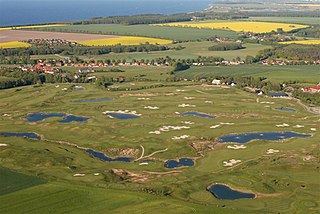
A golf course is the grounds on which the sport of golf is played. It consists of a series of holes, each consisting of a tee box, a fairway, the rough and other hazards, and a green with a cylindrical hole in the ground, known as a "cup". The cup holds a flagstick, known as a "pin". A standard round of golf consists of 18 holes, and as such most courses contain 18 distinct holes; however, there are many 9-hole courses and some that have holes with shared fairways or greens. There are also courses with a non-standard number of holes, such as 12 or 14.

A golf ball is a special ball designed to be used in the game of golf.
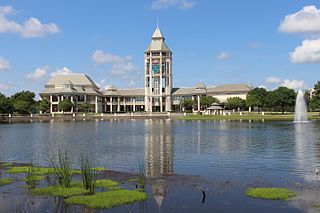
The World Golf Hall of Fame was, until recently, located at World Golf Village between Jacksonville, Florida and St. Augustine, Florida, in the United States. It is unusual amongst sports halls of fame in that a single site honored both men and women. It is supported by a consortium of 26 golf organizations from all over the world. It is moving back to Pinehurst, North Carolina, with the new campus opening in 2024.
The following is a partial timeline of the history of golf.
Rees Jones is an American golf course architect.

Pinehurst Resort is a golf resort in Pinehurst, North Carolina, United States. It has hosted a number of prestigious golf tournaments including three U.S. Open Championships, one U.S. Women's Open, three U.S. Amateur Championships, one PGA Championship, and the Ryder Cup.

Donald James Ross was a professional golfer and golf course designer. Ross was born and raised in Scotland but moved to the United States as a young man. Ross designed dozens of courses across North America and is generally regarded as one of the top golf course designers of all time.
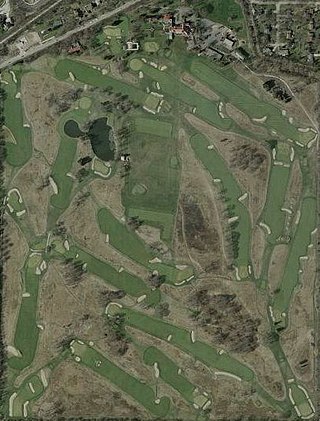
Chicago Golf Club is a private golf club in the central United States, located in Wheaton, Illinois, a suburb west of Chicago. The oldest 18-hole course in North America, it was one of the five founding clubs of the United States Golf Association (USGA) in 1894. It was listed on the National Register of Historic Places in 2020.

Oakland Hills Country Club is a private golf club in the central United States, located in Bloomfield Township, Michigan, a suburb northwest of Detroit. It consists of two 18-hole courses designed by Donald Ross: the South Course (1918) and the North Course (1923).
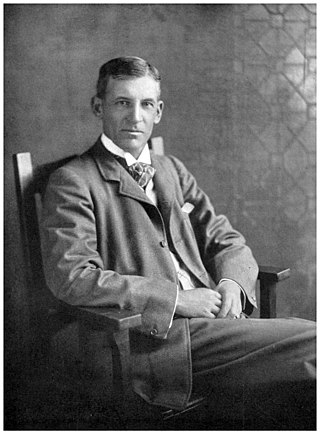
Walter J. Travis was an American amateur golfer during the early 1900s. He was also a noted golf journalist and publisher, an innovator in all aspects of golf, a teacher, and golf course architect.
Paul Dye Jr., commonly referred to as Pete Dye, was an American golf course designer and a member of a family of course designers. He was married to fellow designer and amateur champion Alice Dye.
Arthur Hills was an American golf course designer. He designed more than 200 new golf courses, including private, resort, upscale, and public golf courses around the world. In addition, Arthur Hills' firm, Arthur Hills/Steve Forrest and Associates, has been requested to renovate or modify more than 120 courses, including some of the country's most renowned clubs, often in preparation for major USGA and PGA Championships.
Foursomes, also known as alternate shot, is a pairs playing format in the sport of golf.
Richard Mandell is a noted golf course architect residing in Pinehurst, North Carolina.
Geoffrey St John Cornish was a golf course architect, author, and a fellow of the American Society of Golf Course Architects. He designed over 200 courses, including 9-hole additions, around the world.

Michael John Hurdzan is an American golf course architect, author, and a retired United States Army colonel, who served with the United States Army Special Forces. He is a member and past president of the American Society of Golf Course Architects (ASGCA), who is noted for designing and renovating many golf courses and clubs, including U.S. Open golf courses.

Forrest L. Richardson is an American golf course architect and member of the American Society of Golf Course Architects (ASGCA).
Bradley S. Klein is an American author, senior writer for Golf Channel/GolfAdvisor.com and design consultant on golf course architecture. As an author, he has been collected by libraries worldwide.
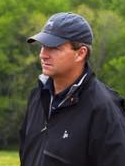
Gilbert Hanse is an American golf course designer. Hanse, along with his business partner Jim Wagner, was selected to design the Rio 2016 Olympic Golf Course, the first Olympic venue to host golf since 1904.











